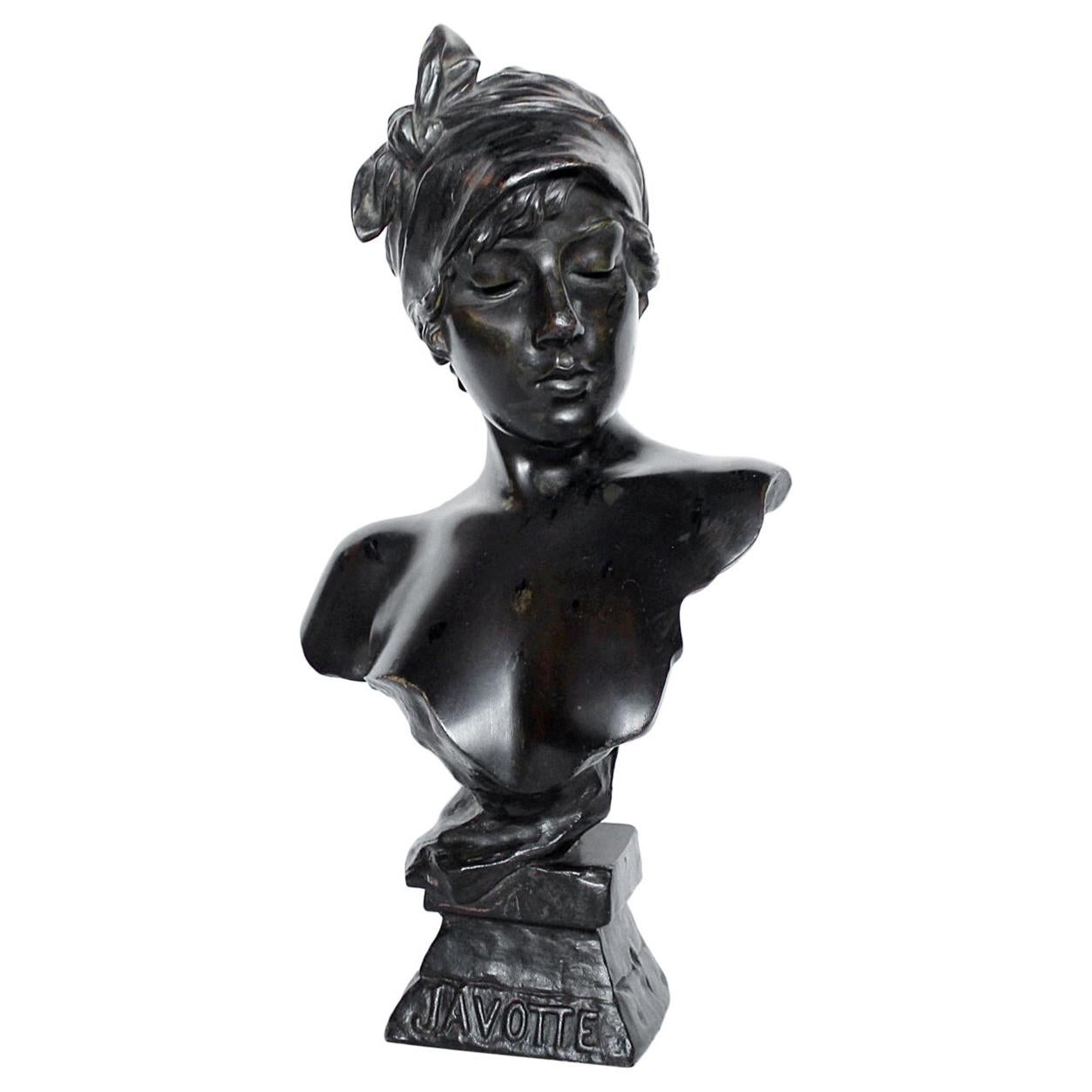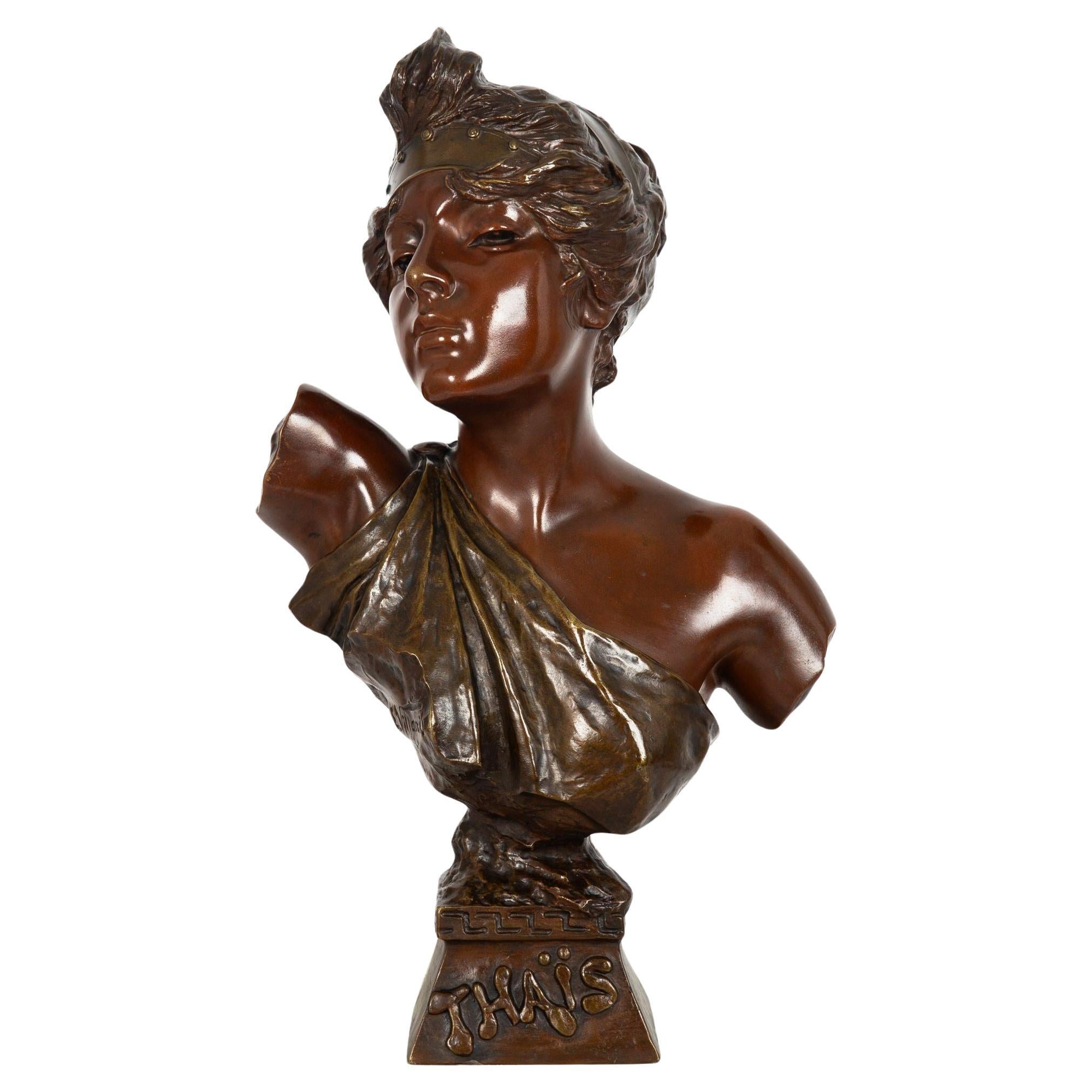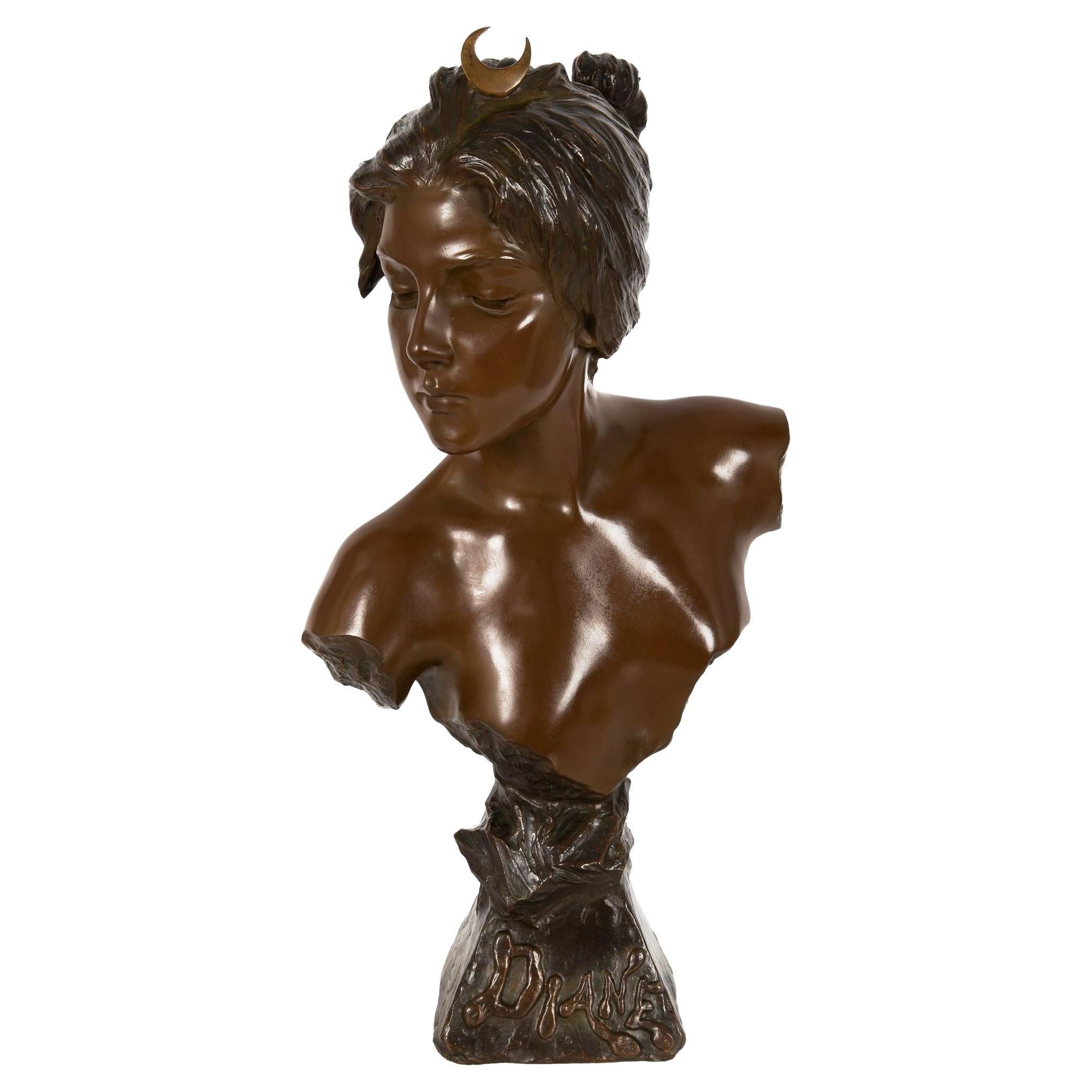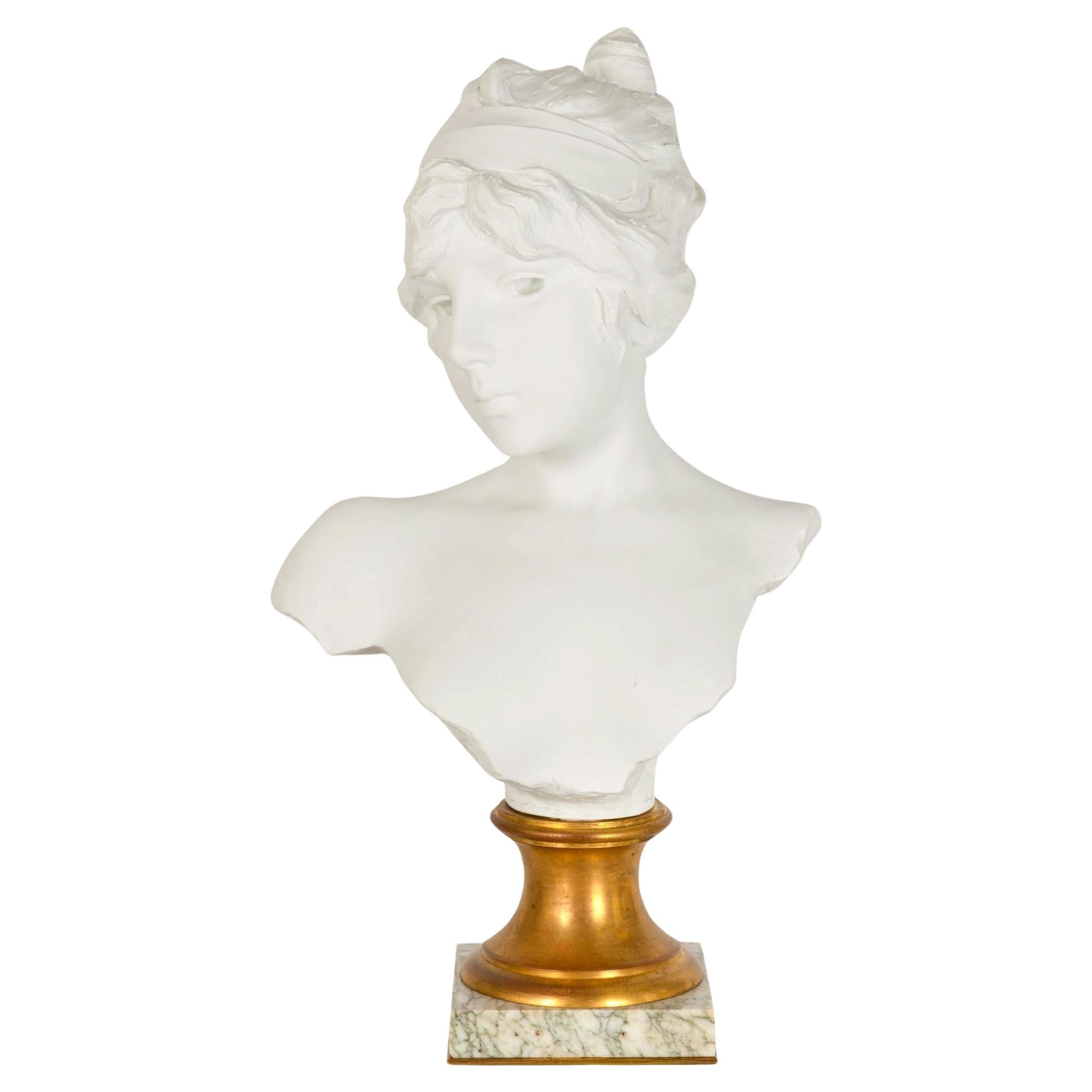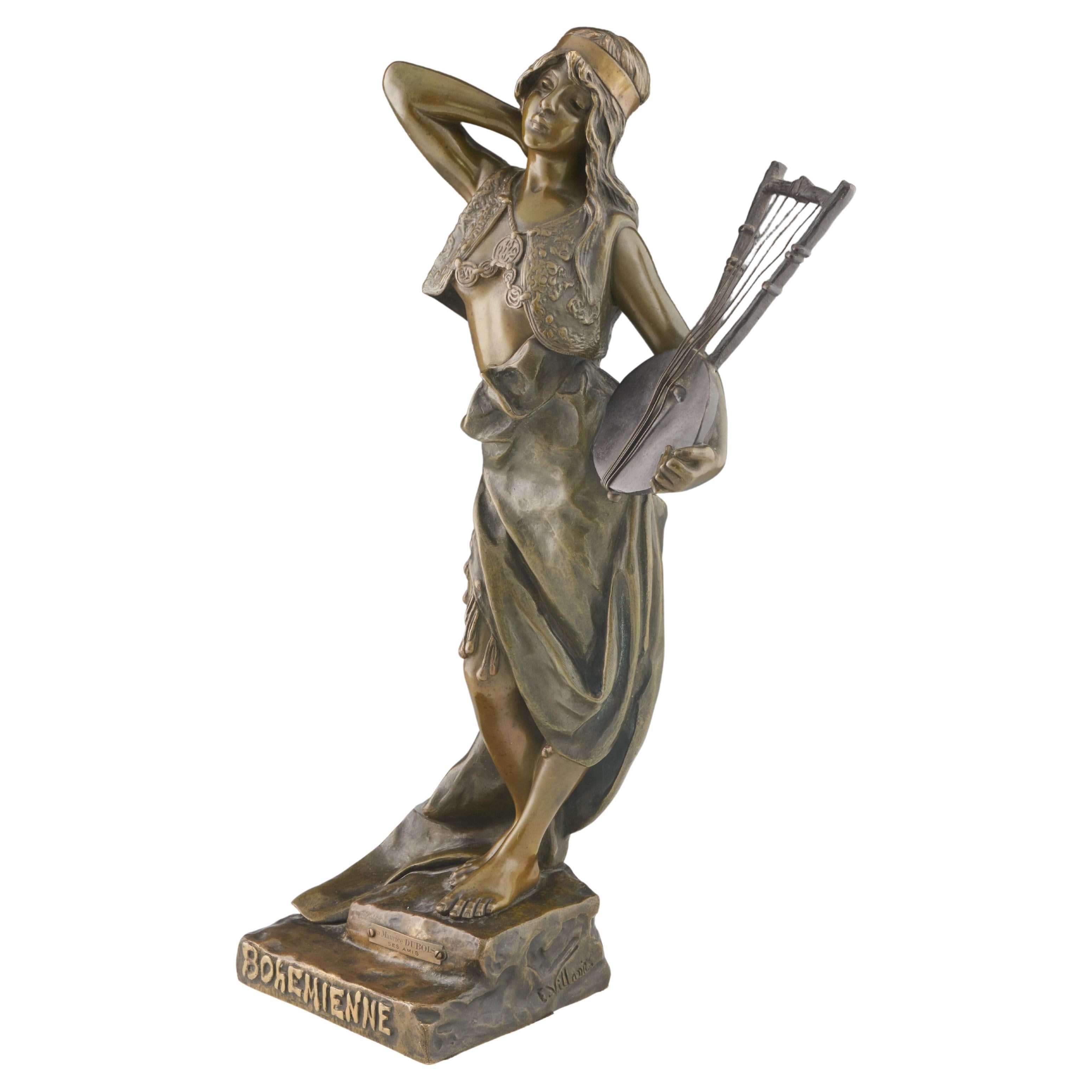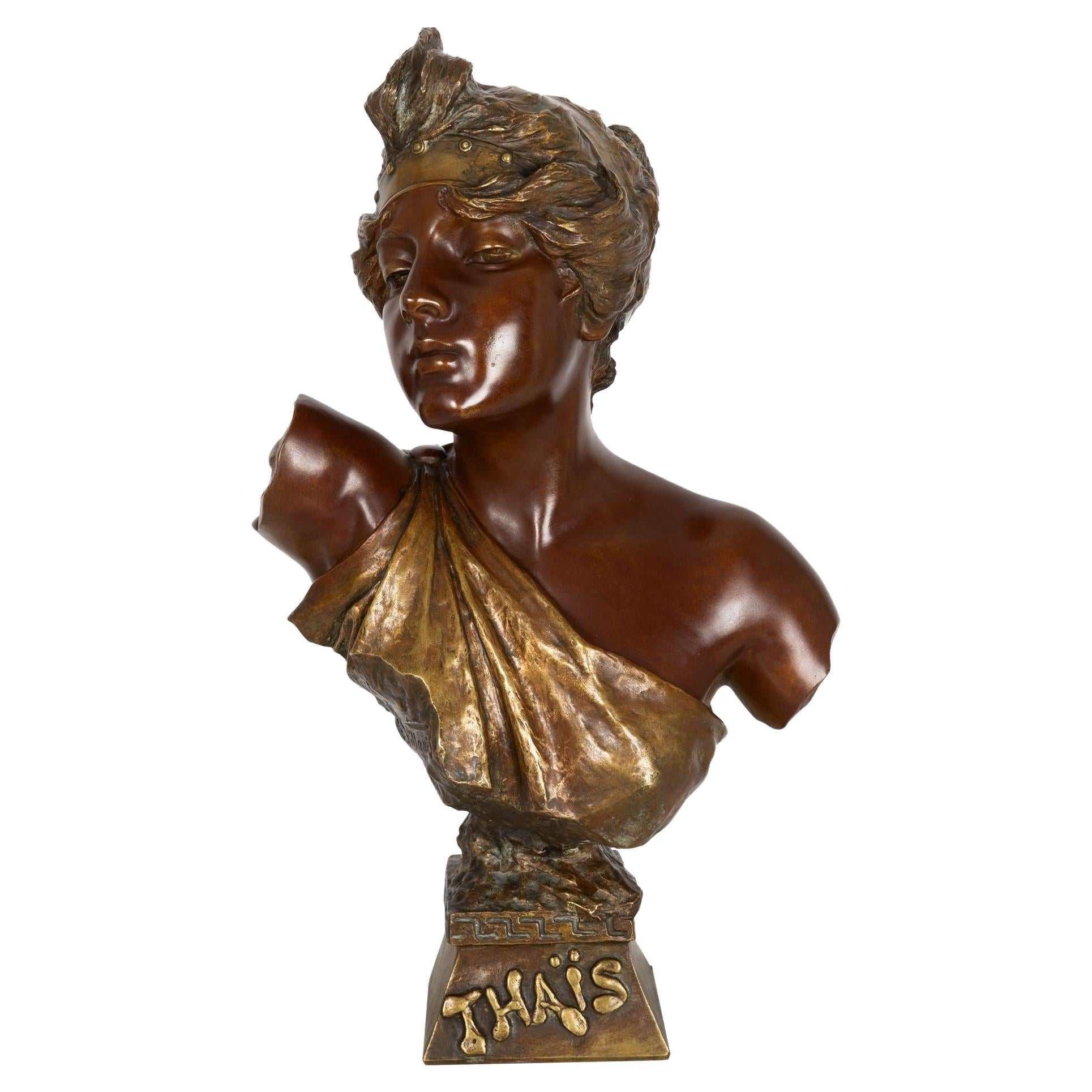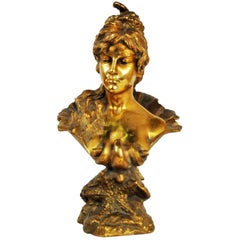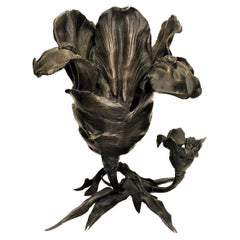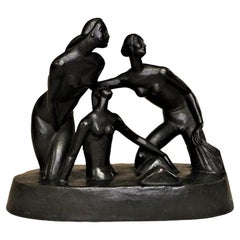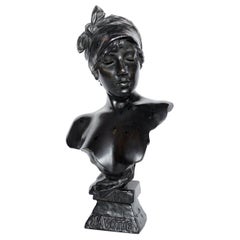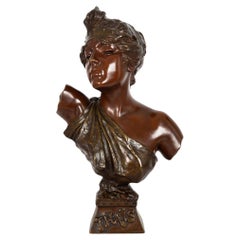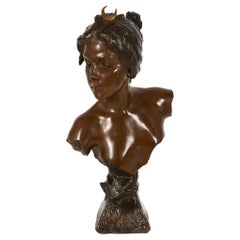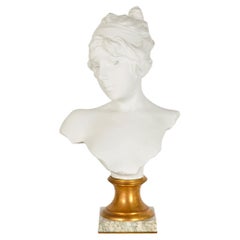Items Similar to Emmanuel Villdnis, ‘Nelly’, French Art Nouveau Patinated Bronze Bust, ca. 1890
Want more images or videos?
Request additional images or videos from the seller
1 of 9
Emmanuel Villdnis, ‘Nelly’, French Art Nouveau Patinated Bronze Bust, ca. 1890
About the Item
DETAILS
Signed and foundry mark on back.
DIMENSIONS
Height: 4-15/16 inches
Width: 2-5/16 inches
Depth: 2.25 inches
ABOUT THE SCULPTURE
This portrait bust is of Nelly Faner, famous burlesque dancer at the turn of the XX Century Paris.
ABOUT THE SCULPTORE
Emmanuel Villdnis (French, 1858 – 1914) was born to Italian parents in France, in 1858. He moved with the family to Piedmont, Italy, in March 1861; after the proclamation of the Kingdom of Italy.
Known in Italy as Villani, he studied at the Academy of Fine Arts Albertina in Turin from 1871 to 1880 alongside master-sculptor Odoardo Tabacchi. When Villanis graduated, he exhibited his first works in cities across Italy, notably his bust ‘Alda’ in Milan, in 1881.
Villanis returned to France in 1885, living and working in the Montmartre district of Paris and didn’t leave Montmartre until his death on August 28th 1914.
Villanis specialised in female bronze busts. Many are based on musical subjects such as opera heroines and composers, as well as famous characters from literature and mythology. The women were beautiful and young and often looked thoughtful, detached and melancholy. They displayed harmonious proportions with each having an oval face, hollow eyes, short nose, full lips and long hair.
His subjects are each found in two or three sizes and mainly made of bronze, pewter or spelter. His busts were cast by the Society des Bronzes de Paris, Bronze Garanti au titre Paris, Vrai Bronze Garanti Paris, E Blot Paris Vrai Bronze and K K Kunst-Erzgiesserei Wien and exported all over the world.
The works of Villanis often feature muti-hued patination, in two or more colours, which is particularly beautiful. They also often feature the title of the piece fairly prominently. During the 19th Century it was vital for a sculptor to exhibit at the Salon des Artistes in order to gain recognition and commissions. Villanis did so 11 times between 1886 and 1910, exhibiting 17 sculptures including the four busts Nerina in 1887, Galatee in 1894, Mignon in 1896 and Judith in 1898. Villanis received an Honourable Mention for the two maquette statues he presented in 1892.
- Creator:Emmanuel Villdnis (Sculptor)
- Dimensions:Height: 4.32 in (10.98 cm)Width: 2.32 in (5.9 cm)Depth: 2.25 in (5.72 cm)
- Style:Art Nouveau (Of the Period)
- Materials and Techniques:Bronze,Patinated
- Place of Origin:
- Period:
- Date of Manufacture:circa 1890
- Condition:Wear consistent with age and use. We make our best effort to provide a fair and descriptive condition report. Please examine photos attentively, as they are an integral part of the description. Send us a message to request more details or discuss price.
- Seller Location:New York, NY
- Reference Number:1stDibs: LU2819330229892
About the Seller
5.0
Gold Seller
Premium sellers maintaining a 4.3+ rating and 24-hour response times
Established in 1993
1stDibs seller since 2017
80 sales on 1stDibs
Typical response time: 2 hours
- ShippingRetrieving quote...Shipping from: New York, NY
- Return Policy
Authenticity Guarantee
In the unlikely event there’s an issue with an item’s authenticity, contact us within 1 year for a full refund. DetailsMoney-Back Guarantee
If your item is not as described, is damaged in transit, or does not arrive, contact us within 7 days for a full refund. Details24-Hour Cancellation
You have a 24-hour grace period in which to reconsider your purchase, with no questions asked.Vetted Professional Sellers
Our world-class sellers must adhere to strict standards for service and quality, maintaining the integrity of our listings.Price-Match Guarantee
If you find that a seller listed the same item for a lower price elsewhere, we’ll match it.Trusted Global Delivery
Our best-in-class carrier network provides specialized shipping options worldwide, including custom delivery.More From This Seller
View AllFrench Art Nouveau, Female Bust, Gilt Bronze, 1900s
Located in New York, NY
Signed under the left shoulder: ”CerNelille”.
Category
Antique Early 1900s French Art Nouveau Busts
Materials
Bronze
French Art Nouveau Patinated Bronze Sculptural Iris Vase, ca. 1900
Located in New York, NY
ABOUT IRIS
The iris is a special and mysterious flower. Not only because of its striking appearance, but also from an artistic and historical point of view. It is also like a work of art, as though created by Mother Nature. The unique leaves of this plant not only create wonderful shadow casts, but also look as if they were painted by hand. It's no wonder that iris acts as the muse for countless artists, and can be seen in many famous works of art.
The iris was first spotted in the time of Pharaoh Thutmose, in 1504 BC. He had the iris inscribed into the wall reliefs of a temple as a sign of his power, as well as decorating his sceptre with motifs of the flower. Since then, the iris has been a symbol of victory in Egypt. But the symbolism of the iris goes further than that. In Japan, the flower represents courage and is the symbol of the boys' festival. In Islamic cultures, the iris is a symbol of prosperity. In Europe, the flower was a popular weapon symbol in the Middle Ages and stood for chivalry. And in Christianity, the iris was seen as a symbol of the trinity because of its three-part flowers. With more than 300 varieties, the iris is now the most popular flower among growers and gardeners following the rose.
Countless artists use the iris in their works and the flower is present in all eras. You can see the flower on furniture, vases, jewelry, fabrics, sculptures, coats of arms and much more. Did you know that the iris is also called the sword lily? It's not a coincidence that it used to symbolize physical and emotional pain and suffering caused by a weapon. We also see the flower in religious art, where it's often associated with Mary and Jesus. The iris is also associated with the Greek goddess Iris, where the flower symbolizes reconciliation and divine messages. This is also reflected in many paintings.
Finally, the iris is also visible in Dutch and Flemish still-life paintings. This can be in a religious form, incorporated into an object or as a decorative flower.
In the Art Nouveau art movement, the iris (along with other plants, such as the birch) was often used as an expression of feminine beauty. With its almost otherworldly appearance, the iris is perfectly suited to the Art Nouveau aesthetic and is featured in many well-known works of art. The poet of that era, Hermann Hesse...
Category
Antique Early 1900s French Art Nouveau Planters, Cachepots and Jardinières
Materials
Bronze
Soccer Player, German Art Deco Patinated Bronze Sculpture, ca. 1930’s
Located in New York, NY
Art Deco
Soccer Player
Patinated Bronze Sculpture
Germany, ca. 1930’s
DIMENSIONS
Height: 9.5 inches Width: 6.75 inches Depth: 2.75 inches
ABOUT
A rare, laconi...
Category
Vintage 1930s German Art Deco Figurative Sculptures
Materials
Bronze
Richard Bauroth, Bathers, German Jugenstil Patinated Bronze Sculpture, Ca. 1919
Located in New York, NY
ABOUT ARTIST
Richard Bauroth (German, 1884-?) was active/lived in Germany. German sculptor, Richard Bauroth studied in Munich et al. under Adolf von Hildebrand.
DIMENSIONS
Heigh...
Category
Vintage 1910s German Jugendstil Figurative Sculptures
Materials
Bronze
Austrian Jugenstil Patinated Bronze Sculpture of Fawn Youth, Ca. 1900
Located in New York, NY
Probably Austrian, this lovely Jugenstil desk-sized black-patinated bronze figurine on its original marble pedestal depicts a fawn youth, checking the size of his tail to see how muc...
Category
Antique Early 1900s Austrian Jugendstil Figurative Sculptures
Materials
Marble, Bronze
Bernhard Sopher, Seated Nude, Art Deco Patinated Bronze Sculpture, Ca. 1930s
By Bernhard Sopher
Located in New York, NY
Signed on the base: ‘B. Sopher’
Well-preserved original dark brown patina.
Dimensions:
Height: 7.5"
Width: 8"
Depth: 7"
Bernhard (Burnat David) Sopher (1879 – 1949) was a German-American sculptor. He was born in Safed, Syria and studied sculpture at the Berin Art Academy from 1897; and from 1905 to 1908, at the Weimar School of Crafts with Adolf Brutt in Berlin and Weimar. At the end of his studies, he was already involved in the realization of the monument to Grand Duke Carl Alexander...
Category
Vintage 1930s American Art Deco Figurative Sculptures
Materials
Bronze
You May Also Like
'Janotte' Emmanuel Villanis Art Nouveau Bronze Bust, French, 1890
By Emmanuel Villanis
Located in Forest Row, East Sussex
Janotte, an Art Nouveau, patinated bronze bust of a young lady with head scarf. Dark brown patination. Set on an integral plinth. Signed Villanis under shoulder.
Signed Villanis u...
Category
Antique Late 19th Century French Art Nouveau Busts
Materials
Bronze
$4,474 Sale Price
25% Off
French Art Nouveau Bronze Sculpture “Bust of Thais” by Emmanuel Villanis
By Emmanuel Villanis
Located in Shippensburg, PA
EMMANUEL VILLANIS
French, fl. 1880-1920
"Bust of Thais"
Cast signature to shoulder "E. Villanis" cold-stamped "3264" & "CB" with foundry cachet of "Societe des Bronzes de Paris" o...
Category
20th Century French Art Nouveau Busts
Materials
Bronze
French Art Nouveau Bronze Sculpture “Bust of Diana” by Emmanuel Villanis
By Emmanuel Villanis
Located in Shippensburg, PA
EMMANUEL VILLANIS
French, fl. 1880-1920
"Bust of Diana the Huntress"
Signed in cast along shoulder "E. Villanis" and cold stamped "3 S" verso
Item # 212KRG15A
An exquisite and expertly cast example of Emmanuel Villanis' Diana the Huntress, it features a delightful light...
Category
20th Century French Art Nouveau Busts
Materials
Bronze
French Parian Porcelain Bust of “Tanagra” after Emmanuel Villanis ca. 1890
By Emmanuel Villanis
Located in Shippensburg, PA
EMMANUEL VILLANIS
French, fl. 1880-1920
"Tanagra"
Parian porcelain bust over gilt bronze plinth raised on marble base over bronze plate signed in shoulder "E. Villanis" cast circ...
Category
Antique 19th Century French Art Nouveau Busts
Materials
Marble, Bronze
'Bohemienne' Art Nouveau Bronze Sculpture by Emmanuel Villanis, circa 1890
By Emmanuel Villanis
Located in Forest Row, East Sussex
'Bohemienne' An Art Nouveau bronze sculpture by Emmanuel Villanis (1858-1914), depicting an elegant young woman holding a lyre with her other arm raised behind her head with robes fl...
Category
Antique Late 19th Century French Art Nouveau Figurative Sculptures
Materials
Bronze
French Art Nouveau Bronze Sculpture “Bust of Thais” by Emmanuel Villanis
By Emmanuel Villanis
Located in Shippensburg, PA
EMMANUEL VILLANIS
French, fl. 1880-1920
"Bust of Thais"
Signed in cast along shoulder "E. Villanis" and cold stamped "1146" with foundry cachet of "Societe des Bronzes et Paris" ve...
Category
20th Century French Busts
Materials
Bronze
Recently Viewed
View AllMore Ways To Browse
Italian Female Bust
Bronzed Spelter
Bronze Dancer Statues
Bronze Statue Of Dancer
Art Nouveau Bronze Female
French Female Statues
Bronze Female Statue France
Art Nouveau Bronze Statue
Statues Of Women
Antique Spelter Statues
Art Nouveau Spelter
Spelter Nouveau
Pewter Oval
Bronze Judith
Bronze Garanti Paris
Antique French Pewter Marks
Spelter Statue Dancer
Mignon Bronze
